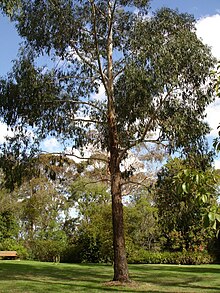Eucalyptus ovata
| Swamp gum | |
|---|---|

| |
| Eucalyptus ovata in Maranoa Gardens | |
| Scientific classification | |
| Kingdom: | Plantae |
| Clade: | Tracheophytes |
| Clade: | Angiosperms |
| Clade: | Eudicots |
| Clade: | Rosids |
| Order: | Myrtales |
| Family: | Myrtaceae |
| Genus: | Eucalyptus |
| Species: | E. ovata
|
| Binomial name | |
| Eucalyptus ovata | |

| |
| E. ovata, field distribution | |
| Synonyms[2] | |
|
Eucalyptus muelleri Naudin nom. illeg. | |
Eucalyptus ovata, commonly known as swamp gum or black gum,[3] is a small to medium-sized tree species that is endemic to south-eastern Australia. It has mostly smooth bark, glossy green, lance-shaped to egg-shaped adult leaves, green flower buds in groups of seven, white flowers and conical to bell-shaped fruit.
Description
Eucalyptus ovata is a tree that typically grows to a height of 17–30 m (56–98 ft) and forms a
Taxonomy and naming
Eucalyptus ovata was first formally described in 1806 by Jacques Labillardière in Novae Hollandiae Plantarum Specimen.[8][9] The specific epithet (ovata) is from the Latin ovatus, referring to the leaf shape.[3]
In 1916, Joseph Maiden described two varieties of E. ovata in his book, A Critical Revision of the Genus Eucalyptus, and the names have been accepted by the Australian Plant Census:
- Eucalyptus ovata var. grandiflora Maiden;[10][11]: 146, 155
- Eucalyptus ovata Labill. var. ovata.[11]: 148 [12]
Distribution and habitat
Swamp gum is widespread in south-eastern Australia and is found from the western end of Kangaroo Island and the southern Mount Lofty ranges in the south-east of South Australia, to Tasmania, the southern half of Victoria and to south-eastern New South Wales as far north as Oberon and Hill Top. It grows in grassy woodland in low, temporarily or permanently damp sites.[3][4][5][7]
References
- . Retrieved 27 October 2021.
- ^ a b "Eucalyptus ovata". Australian Plant Census. Retrieved 24 November 2019.
- ^ a b c d "Eucalyptus ovata". Euclid: Centre for Australian National Biodiversity Research. Retrieved 31 May 2020.
- ^ a b Brooker, M. Ian H.; Slee, Andrew V. "Eucalyptus ovata". Royal Botanic Gardens, Victoria. Retrieved 24 November 2019.
- ^ a b Hill, K. "Eucalyptus ovata Labill". PlantNET. National Herbarium of New South Wales. Retrieved 10 February 2009.
- ISBN 1-876473-28-2
- ^ a b Chippendale, George M. "Eucalyptus ovata". Australian Biological Resources Study, Department of the Environment and Energy, Canberra. Retrieved 24 November 2019.
- ^ "Eucalyptus ovata". APNI. Retrieved 24 November 2019.
- ^ Labillardiere, J.J.H. de (1806). Novae Hollandiae Plantarum Specimen. Vol. 2. Paris, France: Ex typographia Dominæ Huzard. pp. 13–14.
- ^ "Eucalyptus ovata var. grandiflora". Australian Plant Census. Retrieved 24 November 2019.
- ^ a b Maiden, Joseph (1916). A Critical Revision of the Genus Eucalyptus. Sydney: New South Wales Government Printer. Retrieved 24 November 2019.
- ^ "Eucalyptus ovata var. ovata". Australian Plant Census. Retrieved 24 November 2019.

